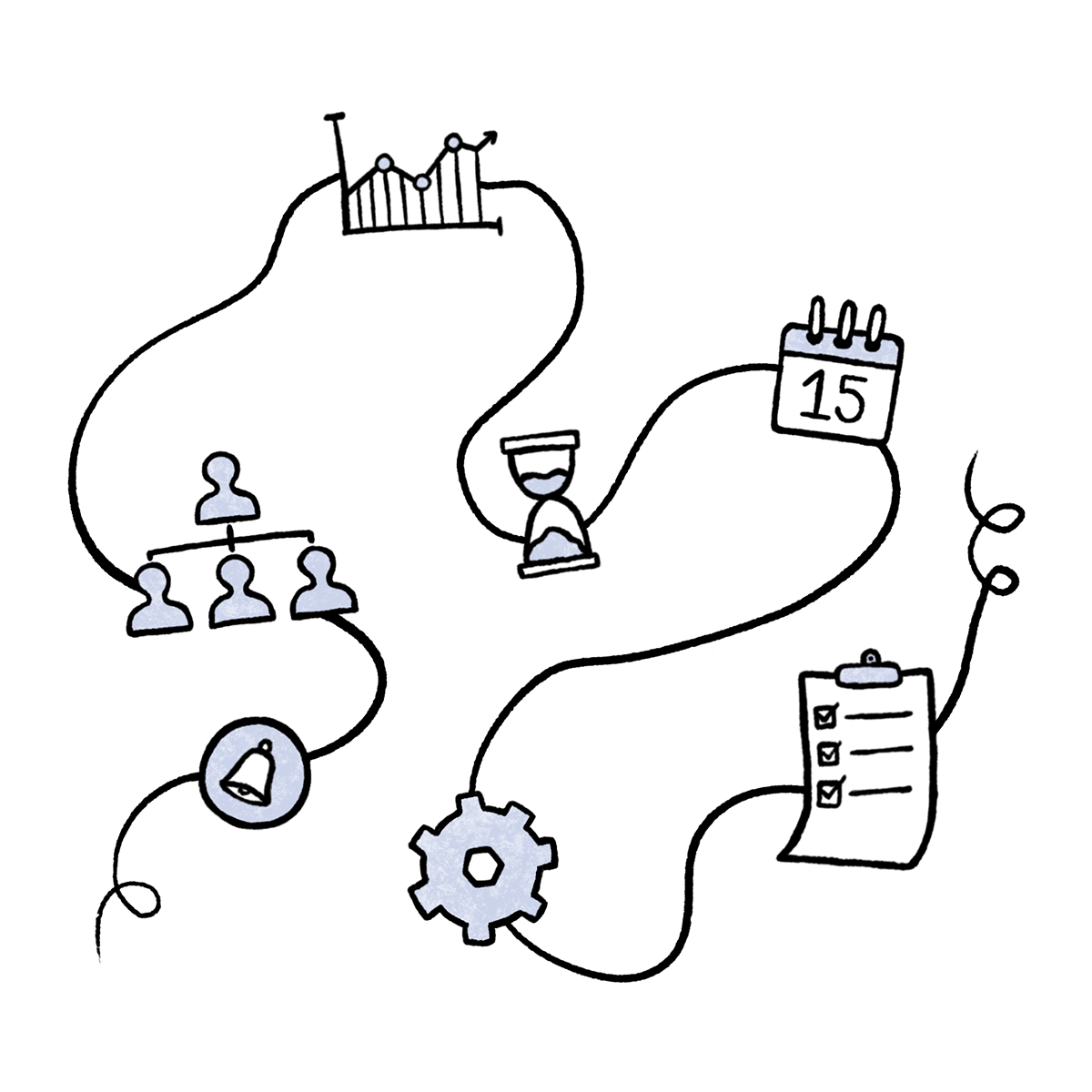16 Tips to Help Improve the Profitability in Your Projects

There are many effective strategies to boost your project profitability. This guide offers 16 actionable tips to help you achieve success.
We've packed this guide with all our insights on profitability, making it quite comprehensive. So, grab a comfortable chair and pour yourself a generous cup of your favorite drink, you're about to dive into a wealth of valuable knowledge.
If you'd like more information on any of the tips in this guide, or if you have any feedback, feel free to contact us here.
1. Get off to a good start: Use a tool for generating offer letters
The first rule for good project profitability is – not surprisingly – to give a precise offer to the customer. If you come off wrong from the start with an imprecise offer, it will affect profitability throughout the whole project.
Templates and electronic acceptance
Start by getting yourself a good tool for generating offer letters. The tool should have various templates to choose from, so you do not have to create each offer completely from scratch. You should also be able to retrieve history from previous projects to estimate the time spend.
If the customer can accept the offer electronically, it will simplify the process and can be used as a basis for the invoice when the time comes. An additional advantage is that you save time after the offer is accepted because you can quickly convert it into a project.
2. Create a detailed project description
The project description is supposed to give the customer a clear picture of what work is included in the project, and what work they are paying for. If any billable work is forgotten in this description, it makes it more difficult to charge for it. This often leads to discussions when the customer receives the invoice.
The project description forms the basis of the offer, so be sure to do a thorough job when creating it. A clear project description ensures that the sales process only promises what can be delivered.
Do not forget the allocation of common costs
Remember that much of the costs outside of the project must also be factored in when you decide on a price model for the project. Should there be a fixed price or an hourly price for your projects? Define the direct project costs but also which common costs in the business must be distributed among the customers. We will go into more detail about price models in chapter 5.
3. Clarify the client's expectations

Frequent clarification meetings with the customer are important, especially in large projects. But how often should these meetings be held and how extensive does the customer want the updates to be?
If the client wants many reviews and adjustments along the way, it will require a lot of time, and this must be factored into the offer. Otherwise, it will lead to poorer project profitability.
Clarify with the customer what expectations they have for:
- Follow-ups
- Reviews
- Adjustments/changes
4. Create time estimates based on previous projects
Being a little too time-optimistic when estimating how long a project will take is quite common, but it can lead to poorer profitability. The time aspect is important for the return (ROI): Whether you deliver the project in eight or twelve months has a lot to say about how the resources will be tied up, and which new projects you can take on.
Look at the data from previous projects, for example how long you spent on different tasks. Have you made good estimates of time use before? Carry out project evaluations during the project to make adjustments along the way.
Remember to include planned holidays: Add holiday days and planned absences in the resource planner. To ensure the outlined progress in the project, it is important to plan for who will cover the tasks when employees are absent.
5. Fixed price or hourly rate? Be aware of which pricing model you operate with
Optimising the working methods is a prerequisite for improving the profitability of the projects. The pricing model for the projects impacts the way you work: Whether you operate with a fixed price or an hourly rate plays a huge role.

Based pricing model: The customer focuses on the result, not how time is spent
Based pricing for projects affects the awareness of how you work, both in the team and with the customer. With a based price, you get to focus on the result of the project and decide for yourself how you use your hours to get there.
This means that you and your team have the responsibility and authority to take the measures you need to carry out the project as efficiently as possible. If you need to make efficiency measures in the company, such as system changes or employee training, you can spend time on this without the customer worrying about how the hours are being spent doing actual production work in the project.
Hourly pricing increases the risk of discussions about the work
If the price of the project is based on hourly consumption, the risk increases of ending up in discussions with the customer about how you work. Even if efficiency measures in the company benefit all customers (because it makes you work smarter and use fewer hours), customers rarely want to pay for the hours spent on this. In other words: The customer would like to benefit from the effect of the measures, but not pay for it themselves.
Disagreement about how you spend the time is a breach of the client's expectations of the project, and the discussions can lead to dissatisfaction. It is time-consuming to sit in discussions with the customer about whether you have spent too much time on a task, or whether they can be invoiced for hours spent on skill development.
Such discussions will also strain your employees if they have to spend time getting the customer to accept the work they plan to do.

6. Identify which costs should be allocated to the customers
Which common costs can be allocated to the customers and what is purely internal time? Get an overview of how the employees' internal time is used. Then, identify which internal time you should factor into the project prices, and which internal time the customers cannot be charged for.
Here are the two categories explained in more detail:
Internal time that can be allocated to the customers' project prices:
These are hours you spend working on things that benefit the customers, but that cannot be directly attributed to a specific customer or project. An example of such customer work is preparing routine descriptions. The hours spent on creating routine descriptions benefit all customers. Therefore, the time spent on this must be distributed among all customers, by calculating it into the project price or hourly price.
Internal time that cannot be allocated to customers:
Employee interviews, office meetings and social events are examples of purely internal time that normally shouldn't be calculated in the project price.
Other costs that must be factored in as well: Sick leave and the like must also be taken into account when determining the price the customer has to pay. If a project participant is absent, you as the supplier are responsible for putting in a substitute, and this risk must be factored into the project price.
7. Categorise the non-billable time as well
If you get an overview of what the non-billable time is actually used for, it is easier to identify patterns and introduce measures that make the use of time more efficient in the business.
Create categories for different types of non-billable time, e.g. reporting, data and IT, competence development and sales work. Perhaps you will discover that internal status meetings take up a lot of time. Then, you can look at possibilities like cutting down on the number of meetings or making the meetings shorter.
8. Routines for reminders, debt collection and work stops
You can work efficiently and deliver a project to the letter, but it doesn't help if the customer doesn't pay. If it costs you a lot of time and money to collect the payment from the customer, it affects profitability.
Agree on payment plans with the customers, with the possibility of a work stoppage in the project if the plan is not followed. It is also important to create routines for sending invoices regularly and to have a payment reminder plan.
9. Resource allocation: Use the right person in the right place
Putting the right employees on the project, and on the right tasks, means a lot to the profitability of the project. Don't let the most expensive resources do tasks that a junior resource can do. Put junior resources on tasks in the project as soon as you have the opportunity. This results in a cheaper hourly rate, and the junior resources gain increased competence by being able to contribute to larger areas of the project.
Role-based resource planning
In Milient's resource planning tool, you can assign each resource several different roles based on the task at hand: Person A can, for example, be a senior resource on frontend development, and a junior resource on backend development. This role-based resource planning allows for flexible planning: You have an overview of the resource needs in the coming weeks and months and can assign Person A to junior tasks when needed and to senior tasks when needed. This way, you get an optimal distribution of the resources.
10. Make a clear timekeeping policy
The more precise the time registration is, the more billable time you get in the projects. Create a clear timekeeping manual that is easily accessible to all employees. It must describe which tasks are to be performed on which activities.
More tips on timekeeping:
Register hours daily
Daily timekeeping is an essential factor for precise timekeeping. Everyone knows how difficult it is to remember exactly what you did back in time. Incorporating good routines for this is worth its weight in gold.
Provide the opportunity for time management from the mobile phone
The best basis for your employees to register time correctly is to have a user-friendly timekeeping system. Choose a system that allows you to register hours on your mobile so that employees do so wherever they are (e.g. on their way from a customer meeting).
Extra tip – for those who use Milient for project management:
In Milient, you can tag time entries, which means that you can subsequently filter the hours in a report. If you want to know how many hours have been registered for follow-up in a project, you can filter using that tag. You can also see how many hours have been spent on a type of activity throughout the organisation.
11. Corrections along the way
Follow up on whether the project is developing as planned along the way. If you discover that you have missed the time estimate or price, it is better to intervene early by notifying the customer and adjusting the offer.
To make it easier for you, set up automatic notifications for hourly consumption in the various project phases. If you have estimated to spend 130 hours in the planning phase, for example, you can set a notification for when 40% of those hours have been used. You will then automatically be notified when the level has been reached and can make adjustments if it happens earlier than expected.
Risk assessment and action plan:
Make plans in advance for what to do if you get in a pinch. Having a plan makes it easier to implement the necessary measures quickly, instead of inventing a solution from scratch when the problem arises.
12. Follow the progress of the project
A project plan is a useful tool for keeping track of the progress of the project and monitoring its profitability. In the project plan, you can measure the time elapsed in the project versus how many hours you have budgeted for.
Estimate the time spent for each project phase:
The project plan must contain a breakdown of how many hours will be used in each phase. That way, you can keep track of how you are doing in terms of time spending along the way.
Compare the estimated time with the actual time spent:
In the project plan, you can compare the forecast for the project with the actual current picture. Are we lagging behind or are we on track? If you discover deviations from the planned time use early on, it is easier to adjust the project.
Schedule follow-up meetings within the team:
It is important to agree on fixed checkpoints with the team along the way to see if you have progressed as far in the work as the time spent suggests. This gives you the chance to see if you are on track.
These checkpoints with the team are also useful for communicating what is expected of those doing the work. There is less risk of the project participants spending more time than estimated if they are aware of the time that is planned to be spent. Expected hours use sends a signal that everyone must have the perception that every hour counts.
In the project plan, you can compare the current situation with the forecast:
The view of the current state of the project shows the hours that have been registered in the project, and what hours are planned for the future. You can easily compare it with previous periods in the project. How are you doing now compared to after 1 week, 2 months or 6 months into the project?
13. Adjust your prices
You'd be surprised how many companies don't adjust their prices regularly. Make sure you have a good routine of regularly updating prices for consulting hours, products and materials. If you have a system that allows you to update in bulk (e.g. adjust all hourly fees by 3% from a given date), this will require minimal time, but it can potentially have a big impact on profitability.
If you have projects that span many years, price increases along the way must be included in the project description. This also applies to customers who have a subscription.
14. Provide for best practice: Build system value with templates and checklists
Documenting optimal work routines makes sure that everyone in the project works as efficiently as possible. With effort, you can build system value by preparing
- Task descriptions
- Work templates
- Routine descriptions
- Checklists
Make sure it can be reused in the projects. This work lays a solid foundation for all the project participants to know what they have to do and what is expected of them.
Redoing things is expensive
All documentation must be easily accessible to everyone working on the project so that it is actually used every day. Doing things over again is expensive. Make sure everyone follows the routines so that you do things right the first time.
Best practice
y systematically creating descriptions and templates for your work routines, you can better understand your processes and identify which methods are the most profitable. This aligns with best practice thinking: If your organisation uses four different approaches, one is likely to outperform the others
Labeling a method as 'best practice' doesn't mean it's 100% optimal—it simply reflects the best approach the organisation currently has. From there, you can continue refining and improving that method.
When a work routine is updated, it is important that the correct version is available to all the project participants, and that they are notified about the update. This way, everyone is kept informed about the working method that applies.
15. Clear cooperation routines
In the same way that routine descriptions must be available to everyone in the project, everyone in the project must be informed about who works in the team, and who has which roles and tasks. It should be easy to find out who to ask if you are wondering about something, and who to consult with if you are waiting for someone else to do their part of the work.
Documenting the work in progress
Have routines that ensure that everyone documents their work. It will then be easier to collaborate and follow up on the progress of the project. It also simplifies task reallocation if an employee becomes ill, resigns, or otherwise becomes unavailable. This saves time and effort – and contributes to better profitability.
16. Combine functions into one system
Working in several different systems where none of the functions talk to each other leads to unnecessary extra work for you and your employees. With the right project management system, you can collect offers, invoicing and time registration in one place. It saves you time and you can keep track of the projects.
Sit down and calculate how much time you (and your employees) spend each week on manual work in various systems. If you can save x number of minutes per employee each week, it will pay off with a complete project system.
Milient has been created to streamline the processes of anyone who works on a project basis, gathering all the functions in one place. Read more about how different industries use Milient.
Reliable Documentation Tools Enhance Security
Storing all project documentation in a single system creates a valuable history that allows you to trace and rectify any mistakes that may have been overlooked. Additionally, if someone accidentally deletes something or makes an error, the work is not lost—it's preserved in the version history

Improve the flow in your projects
We would be happy to have a chat about how Milient can solve your project problems. Book a meeting with us today!

.png?width=1024&height=1024&name=New%20Merge%20Boost%20Post%20(600%20x%20338%20px).png)
.png?width=1024&height=1024&name=thumbnail_Milient-x-Cubic-Interactive-Press-Release-(2).png)
